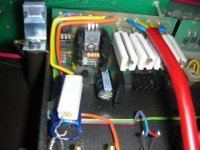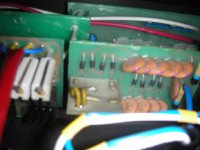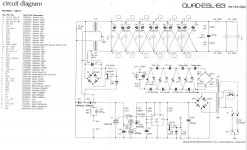Hi Everyone,
I recently traded for a pair of Quad ESL 63's (US studio version). The problem one is currently having is that it's playing back at reduced volume, no pops, hiss, crackles, or distortion, just reduced volume. (the neon bulb isn't flashing every second, I only get a flash when I first turn it on) After thumbing through the service manual it seems like it's probably the EHT board. I would like to rebuild it with slightly beefier components and I was wondering if I could get some suggestions from those who are more familiar with the 63's.
I know you can buy pre-done boards but, where's the fun in that? (and I'm a little on the broke side at the moment :-D )
:-D )
According to the service manual the Caps are 10nf -20 +50% at 2KV
would moving up to a higher voltage rating be worth the extra money, and perhaps switching to metalized polypropylene?
The diodes are 1AV30's these are the specs I was able to find online for them:
I(O) Max.(A) Output Current 10m
V(RRM)(V) Rep.Pk.Rev. Voltage 3.0k
t(rr) Max.(s) Rev.Rec. Time 300n
@I(F) (A) (Test Condition)
@I(R) (A) (Test Condition)
V(FM) Max.(V) Forward Voltage 15
@I(FM) (A) (Test Condition) 10m
@V(RM) (V) (Test Condition)
I(RM) Max.(A) Reverse Current 2.0u
@V(R) (V)(Test Condition) 3.0k
I(RM) Max.(A) Pk. Rev. Current 5.0u
@V(R) (V) (Test Condition)
@Temp. (øC) (Test Condition) 75õ
Semiconductor Material Silicon
Maximum Operating Temp (øC) 80’
Would a GP02-30-E3/73GICT-ND work as a replacement?
And should I change any of the resistors on the EHT board? and if so do you know what wattage I should get, I didn't see it mentioned in the service manual.
Thanks
I recently traded for a pair of Quad ESL 63's (US studio version). The problem one is currently having is that it's playing back at reduced volume, no pops, hiss, crackles, or distortion, just reduced volume. (the neon bulb isn't flashing every second, I only get a flash when I first turn it on) After thumbing through the service manual it seems like it's probably the EHT board. I would like to rebuild it with slightly beefier components and I was wondering if I could get some suggestions from those who are more familiar with the 63's.
I know you can buy pre-done boards but, where's the fun in that? (and I'm a little on the broke side at the moment
According to the service manual the Caps are 10nf -20 +50% at 2KV
would moving up to a higher voltage rating be worth the extra money, and perhaps switching to metalized polypropylene?
The diodes are 1AV30's these are the specs I was able to find online for them:
I(O) Max.(A) Output Current 10m
V(RRM)(V) Rep.Pk.Rev. Voltage 3.0k
t(rr) Max.(s) Rev.Rec. Time 300n
@I(F) (A) (Test Condition)
@I(R) (A) (Test Condition)
V(FM) Max.(V) Forward Voltage 15
@I(FM) (A) (Test Condition) 10m
@V(RM) (V) (Test Condition)
I(RM) Max.(A) Reverse Current 2.0u
@V(R) (V)(Test Condition) 3.0k
I(RM) Max.(A) Pk. Rev. Current 5.0u
@V(R) (V) (Test Condition)
@Temp. (øC) (Test Condition) 75õ
Semiconductor Material Silicon
Maximum Operating Temp (øC) 80’
Would a GP02-30-E3/73GICT-ND work as a replacement?
And should I change any of the resistors on the EHT board? and if so do you know what wattage I should get, I didn't see it mentioned in the service manual.
Thanks
I use those GP02-30 diodes in my EHT rebuilds. The 63 EHT's are typically pretty reliable, especially compared to the original ESL supplies. There's three things that I've seen go bad: The MOV in the front end, the diodes, and the capacitors. Typically the diodes are my first suspect, and I shotgun all the diodes. I then check the MOV. The voltage going to the multiplier string should be about 500V. IF that's correct, and the diodes are replaced, I then shotgun all the ceramic caps.
The neon bulb should flash when the speaker if first turned on and then blink slower and slower as the panels charge. If you are in a dry climate and have good clean panels, it can be 30 seconds or longer between flashes.
Because you have low output, that board is a reasonable place to check.
One easy thing to do is to swap bases between speakers and see if the problem follows the bass or not. The bases are held to the panel assembly with 8 nuts and three wires (plus antenna). So it's pretty easy to swap. And that will tell you where you need to be looking for the problem.
Sheldon
The neon bulb should flash when the speaker if first turned on and then blink slower and slower as the panels charge. If you are in a dry climate and have good clean panels, it can be 30 seconds or longer between flashes.
Because you have low output, that board is a reasonable place to check.
One easy thing to do is to swap bases between speakers and see if the problem follows the bass or not. The bases are held to the panel assembly with 8 nuts and three wires (plus antenna). So it's pretty easy to swap. And that will tell you where you need to be looking for the problem.
Sheldon
Here's what I've been able to put together so far
8 diodes GP02-30 (Mouser part# 625-GP02-30-E3)
14 Capacitors (for the EHT board) 10nF @ 2KV (Mouser part# 594-S103M69Z5UP63K7R)
1 Capacitor (for the neon board) 47nF @250 (I went with Mouser part# 505-MKP4J024703FKSSD)
1 Varistor (Mouser part# 871-B72210S461K101)
Resistors:
2 220K @ 5% (Mouser part# 279-RR02J220KTB)
1 180K @5% (Mouser part# 594-5083NW180K0J)
1 56k @ 5% (Mouser part# 594-5083NW56K00J)
1 10M @ 5% (Mouser part# 594-VR37000001005FA1)
I have the M-12525 ISS 4 version of the board
8 diodes GP02-30 (Mouser part# 625-GP02-30-E3)
14 Capacitors (for the EHT board) 10nF @ 2KV (Mouser part# 594-S103M69Z5UP63K7R)
1 Capacitor (for the neon board) 47nF @250 (I went with Mouser part# 505-MKP4J024703FKSSD)
1 Varistor (Mouser part# 871-B72210S461K101)
Resistors:
2 220K @ 5% (Mouser part# 279-RR02J220KTB)
1 180K @5% (Mouser part# 594-5083NW180K0J)
1 56k @ 5% (Mouser part# 594-5083NW56K00J)
1 10M @ 5% (Mouser part# 594-VR37000001005FA1)
I have the M-12525 ISS 4 version of the board
So I rebuilt the EHT board and it's putting out the correct HV but somethings not right with the clamp/detector board board, I'm only getting very faint audio through the speaker with the amp turned up. (before it was slightly reduced but all there, no distortion etc.) The only thing I did on the clamp/ detector board was to replace C28 (1,000 uF electrolytic) since it was original and getting up there in age.
I've been going through the trouble shooting section in the service manual and when I get to the point were it says to measure the DC volts on the gate of T1, I get only 1.2 mV. the block manual only cares if it's greater than 0.25 volts it doesn't mention what the normal value should be. But if I ignore that it suggests that my problem might be D11 and D12, Does that sound like it could be the culprit?
I've been going through the trouble shooting section in the service manual and when I get to the point were it says to measure the DC volts on the gate of T1, I get only 1.2 mV. the block manual only cares if it's greater than 0.25 volts it doesn't mention what the normal value should be. But if I ignore that it suggests that my problem might be D11 and D12, Does that sound like it could be the culprit?
Based on your last post, I'm assuming that the the bad speaker is WAY quieter, like 20dB down. Chances are that your clamp TRIAC is bad. The spark clamp circuit turns on an TRIAC that shorts the speaker input (because screw your amp). IF that TRIAC has to sink too much current, it can fail. This leads to it always being "on" and your speaker always being shorted and thus very quiet.
Pull the TO-220 device on the heat sink off the clamp board and try your speaker. I bet it will play like before. I've seen this several times on over-driven speakers.
There were several clamp-board variations, some had a couple of heat sinked to-220 devices. if you are confused drop me an email with a picture of your board and I'll be glad to help you out.
Sheldon
quadesl.com
Pull the TO-220 device on the heat sink off the clamp board and try your speaker. I bet it will play like before. I've seen this several times on over-driven speakers.
There were several clamp-board variations, some had a couple of heat sinked to-220 devices. if you are confused drop me an email with a picture of your board and I'll be glad to help you out.
Sheldon
quadesl.com
Did you have any success troubleshooting your speaker? I am running in the same issue. Both my Quad ESL-63 play quietly. I have replaced all diodes and caps on one of the EHT board and now the speaker plays even more faintly. I can barely hear any sound at all.
I haven't tried swapping the bases or the EHT boards yet.
Should I try replacing the TRIAC T2800B and TAG92A-3 on the clamp board? Do you know what part number I could use to replace them?
Thanks
I haven't tried swapping the bases or the EHT boards yet.
Should I try replacing the TRIAC T2800B and TAG92A-3 on the clamp board? Do you know what part number I could use to replace them?
Thanks
Yes, you should replace the triac which is driven by the 555 timer. Remove it from the board and try running the speaker without it. You won't hurt anything if it's not there, you just won't have the clamp circuit, so don't go crazy with the speaker.
Write back if that doesn't fix it.
Sheldon
quadesl.com
Write back if that doesn't fix it.
Sheldon
quadesl.com
The fact that the caps are physically disconnected from the panels when the neon isn't lit is a pretty compelling argument for not being too concerned about the HV caps. Films won't hurt anything, but don't expect any sonic improvements. The trick is to find films that would fit on the board. You can lay out a new board with films and then everything is good.
Here's a new layout or the HV boards:
OSH Park ~
Sheldon
quadesl.com
Here's a new layout or the HV boards:
OSH Park ~
Sheldon
quadesl.com
Based on your last post, I'm assuming that the the bad speaker is WAY quieter, like 20dB down. Chances are that your clamp TRIAC is bad. The spark clamp circuit turns on an TRIAC that shorts the speaker input (because screw your amp). IF that TRIAC has to sink too much current, it can fail. This leads to it always being "on" and your speaker always being shorted and thus very quiet.
Pull the TO-220 device on the heat sink off the clamp board and try your speaker. I bet it will play like before. I've seen this several times on over-driven speakers.
There were several clamp-board variations, some had a couple of heat sinked to-220 devices. if you are confused drop me an email with a picture of your board and I'll be glad to help you out.
Sheldon
quadesl.com
Hi Sheldon,
I hope you are still around and I hope it´s ok for Thinker1920 that I ask this, but my problem is exactly the same.
When you mean "pull the TO-220 device", you mean to unsolder or really to pull? (I am by no means a pro, so I have to start from the beginning, even if this sound funny to some.)
Anyway, if the clamp-board is not the problem, than this means that I have to repair the eht-board, or it could be something else?
I hope you can help me
P.S. I can take better Pictures, if needed.
Attachments
Hi Sheldon,
I hope you are still around and I hope it´s ok for Thinker1920 that I ask this, but my problem is exactly the same.
When you mean "pull the TO-220 device", you mean to unsolder or really to pull? (I am by no means a pro, so I have to start from the beginning, even if this sound funny to some.)
Anyway, if the clamp-board is not the problem, than this means that I have to repair the eht-board, or it could be something else?
I hope you can help me
P.S. I can take better Pictures, if needed.
First of all make sure your EHT board isn't the issue. Take a look at the good speaker and note how fast the neon bulb is blinking. Now look at the bad speaker and see if the bulb is blinking at roughly the same rate. If the bad speaker isn't blinking at a much lower rate or not at all, you probably have an EHT problem. The real way to be sure it's not an eht problem is to swap them from speaker to speaker.
Yes, if the triac is bad, you can unsolder it from the board and try the speaker and it should be back to normal level.
Sheldon
quadesl.com
Hi Sheldon,First of all make sure your EHT board isn't the issue. Take a look at the good speaker and note how fast the neon bulb is blinking. Now look at the bad speaker and see if the bulb is blinking at roughly the same rate. If the bad speaker isn't blinking at a much lower rate or not at all, you probably have an EHT problem. The real way to be sure it's not an eht problem is to swap them from speaker to speaker.
Yes, if the triac is bad, you can unsolder it from the board and try the speaker and it should be back to normal level.
Sheldon
quadesl.com
thank you for the quick answer. The neon bulb at the bad speaker is not blinking at all, only once, when I turned it on. At the good speaker is blinking pretty fast at the beginning, and after a while every 15-20 sec (I didn´t count it), so here seems to be ok.
When you say "swap", I presume you mean only the eht-board, not the whole base, otherwise I would swap the problems with it.
Chris
My guess is that you have a bad diode on your EHT board. I'd swap all 8 of them.
Sheldon
Hi Sheldon,
I was afraid you´d say that
Funny thing, on my eht-board I have 8+5 diodes, and I don´t see this in the schematic, but I´m not good at reading this either
Again, thank you for your time!
Chris
Attachments
Hi Sheldon,
I was afraid you´d say that. I´m not that good at soldering, but I can try. All I´ve got is this schematic, I presume that means that D3-D10 had to be changed (what is 1AV30?).
Funny thing, on my eht-board I have 8+5 diodes, and I don´t see this in the schematic, but I´m not good at reading this either.
Again, thank you for your time!
Here's two different versions of the EHT board, note the black devices with a silver band. Those are the diodes in question. There are eight of them on each board.
Here's the diode that are used in the later model quad power supplies. I use these:
https://www.digikey.com/product-det...on/GP02-30-E3-73/GP02-30-E3-73GICT-ND/3025889
The diodes are directional, make sure you put them in the right way.
hope that helps,
Sheldon
quadesl.com
So much important and useful information for me in your post!
Here's two different versions of the EHT board, note the black devices with a silver band. Those are the diodes in question. There are eight of them on each board.
This is really embarrassing, because I thought that the diodes are round thingsThat´s how skiled I am
(my eht-board, by the way, is the left one).
"The diodes are directional, make sure you put them in the right way."
That is new to me, I don´t remember to have read this before. Again, thank you.
And I´ll search for the Vishay diodes, I´m in Germany, so I´ll have to look somwhere else, but I´m sure I can find them.
So, your post reallly helped!
Chris
Here is the German page priced in Euros.
GP02-30-E3/73 Vishay Semiconductor Diodes Division | Discrete Semiconductor Products | DigiKey
GP02-30-E3/73 Vishay Semiconductor Diodes Division | Discrete Semiconductor Products | DigiKey
Here is the German page priced in Euros.
GP02-30-E3/73 Vishay Semiconductor Diodes Division | Discrete Semiconductor Products | DigiKey
Hi Misterdog!
Yeah, I saw that too, thanks. Now I just have to find out how to put the diodes in the right direction and how to solder them (they´re so tiny!). The speaker-crossover I did were a little bit larger
Chris
- Home
- Loudspeakers
- Planars & Exotics
- Parts list for Quad ESL 63 EHT board


